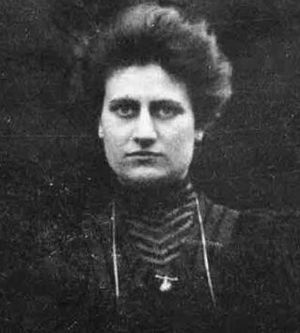Bertha De Vriese facts for kids
Quick facts for kids
Bertha De Vriese
|
|
|---|---|

1904 at the Anatomical Convention of Jena
|
|
| Born |
Bertha Coletta Constantia De Vriese
26 September 1877 Ghent, Belgium
|
| Died | 17 March 1958 (aged 80) Ghent, Belgium
|
| Nationality | Belgian |
| Other names | Bertha Vercoullie |
| Occupation | physician |
| Years active | 1903–1958 |
| Spouse(s) | Josef Vercouillie |
Bertha De Vriese (born September 26, 1877 – died March 17, 1958) was an amazing Belgian doctor. She made history at Ghent University by being the first woman to do research there and the first woman to graduate as a doctor. Even though she couldn't become a professor at the university, she opened her own clinic for children. She also became the head of the Children's Ward at the Bijloke Hospital in Ghent. In 1914, she married Josef Vercouillie, who was also a doctor.
Contents
Bertha's Early Life and Schooling
Where Bertha Grew Up
Bertha Coletta Constantia De Vriese was born on September 26, 1877. Her family lived in the Coupure neighborhood of Ghent, Belgium. Her parents were Coralie Pannenmaeker and Lodewijk De Vriese.
Girls and Education in Belgium
For a long time, girls in Belgium couldn't go to high school. This changed in 1864. After that, universities slowly started to open their doors to women. The University of Brussels was one of the first, allowing women to study there in 1876.
A new law in 1890 made it possible for women to attend medical school. But there was a rule: women needed a high school certificate or had to pass a special test.
Bertha's Path to University
Bertha was taught at home to get ready for university. She passed her special exams in 1893. Right away, she joined Ghent University. She was the very first woman to be accepted into medical school there!
She graduated in 1900 with the highest honors, called summa cum laude. She earned diplomas in medicine, helping with childbirth, and women's health. She was the first woman to graduate in medicine from the university. The next year, she won a special prize and a gold medal from the mayor of Ghent.
Winning a Special Award
Bertha competed against male students with her research paper. It was about Investigating the changes humans undergo on the distribution of blood vessels in the extremities during development. She scored an amazing 95 out of 100 points!
Because she won this award, she received a scholarship from 1899 to 1901. This allowed her to travel and study in many famous cities. She visited places like Berlin, London, Paris, and Vienna.
Bertha's Career as a Doctor
Working at the University
In 1903, Bertha came back to Ghent. She wanted to work in the anatomy lab with Hector Leboucq. She hoped to have a career teaching and doing research at the university.
However, no woman had ever worked in a lab there before. So, Leboucq had to ask for permission from many people. He asked the university council, the main leader of the university (called the rector), and even the Education Ministry. Finally, they said yes!
Bertha became the first woman to work as an assistant in an anatomy lab. If she completed two years of training and published her research, she could become a professor.
Becoming a Specialist
In 1905, Bertha earned a special certificate in anatomy. Her research was about Research on the morphology of the basilar artery. Around this time, the university was changing to focus more on research. Bertha asked to stay longer as an assistant to meet the new requirements for a lead researcher.
Even though her colleagues, the rector, and the minister praised her, the ministry said no to her request.
Leaving the University and Helping Children
After trying for a long time to get the extension, Bertha left Ghent University in 1908. That same year, she started working at the Bijloke Hospital. She worked in the children's ward, helping young patients.
In 1914, she married Josef Vercouillie, who was also a doctor. In the same year, she opened her own private clinic just for children's health. Later, she became the head of the children's department at Bijloke Hospital. She also worked as a medical inspector for public schools, making sure children were healthy.
Bertha's Legacy
Bertha De Vriese passed away on March 17, 1958, in Ghent. She left behind a special collection of bones, muscles, and organs that she prepared for study. These are now kept at the Anatomical Museum at Ghent University. There's even a student dormitory on the university campus named after her!

